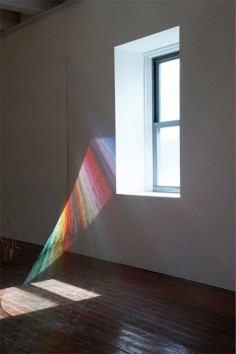MARK GARRY

source: kerlingallery
b. 1972, Mullingar, Ireland.
Born and currently based in Ireland, Mark Garry is driven by a fundamental interest in observing how humans navigate the world and the subjectivity inherent in these navigations. Though he uses a variety of media and mechanisms in his practice, he primarily focuses on institution-based installations. These delicately considered site-specific installations are measured and quiet, requiring meticulous systems of construction. They combine physical, visual, sensory and empathetic analogues, creating arrangements of elements that intersect the space and form relationships between a given room and each other.
These installations incorporate a specific range of natural and craft materials and processes such as plants, thread, beads, woodcarvings and manufactured materials such as colored contact, origami, and mechanical musical mechanisms. Spectrums of coloured threads are in many cases the central element of these installations. This practice is a generative process and involves the stretching and consolidating of the physical capabilities of the materials he work’s with, both as individual entities and when combined with other materials and objects. Through his intervention one’s perception of these materials is altered fundamentally from their utilitarian origins.
Recent solo exhibitions include A New Quiet, Royal Hibernian Academy (2015); Lafayette Projects, Marseille; City Gallery, Charleston, South Carolina; The Model, Sligo (all 2014); ENart Taichung, Taiwan (2013); University of Ulster, Belfast (2011); MiMA, Middlesbrough; Dublin City Gallery The Hugh Lane (both 2009) and Douglas Hyde Gallery (2006). Recent group exhibitions include Island, Galleria Civica di Modena, Milan (2013); All Humans Do, White Box, New York and The Model, Sligo (2012); Unrealised Potential, VOID, Derry; De l’émergence du Phénix, curated by Caroline Hancock, Centre Culturel Irlandais, Paris (both 2011); Reverse Pedagogy, The Model, Sligo; The Hugh Lane (both 2009) and Exquisite Corpse, Irish Museum of Modern Art (2008). Mark Garry was one of the artists who represented Ireland at the 2005 Venice Biennale.
.
.
.
.
.
.
.
source: newlyinstalledtumblr
Mark Garry is an Irish artist who works primarily with site-specific installations for galleries. A quick glance at his work demonstrates that he is not purely a “fiber artist,” i.e. he works in a variety of media (his biography states that he uses “plants, thread, beads, woodcarvings and manufactured materials such as colored contact, origami, and mechanical musical mechanisms” and doesn’t say if he took coursework specializing in fibers). So, while he incorporates thread into his work, which is a fiber-based material, he may not have any other formal background in fiber arts. I think this outside perspective can be helpful in pushing the boundaries of a medium in new ways. I feel like the work of fiber artists (or artists who work in any one particular medium, for that matter) can get bogged down in the technicalities. When you know so much, or, as we often say at school, have so many skills in your “toolbox,” you get this desire sometimes to combine every technique you know into one piece. I don’t find this to be an awful tendency; I think it definitely has a place in a body of work. However, sometimes I think the simplest design solution can be the most beautiful.
It is interesting, too, to view Garry’s first exploration of this threaded structure. He has been working with iterations of the same basic concept since at least 2004, and I think they have become better and more complex over time. “Being here” was the most widely discussed on the internet and I think it might be because Garry has hit the right balance between complexity and simplicity, and is really controlling all of the variables here. It is maybe most compelling because of the way it interacts with the light from the windows. Despite still having the appearance of moving (darting may even be a more accurate description) through space, Garry’s similar works in windowless or uniformly-lit spaces appear flat or neutered in some way, compared to the complexity and the depth of “Being here.”
I love the detail shot on the left. Beautiful and meticulous work. That cute, imperfect line of pins makes something that looks so polished at a distance have this instantly human quality. Proof that even on the large-scale, the small details are still important, and, when thoughtfully considered, can make a big impact in the overall experience of viewing the piece.
In this video, Garry talks a bit more about materials selection and the process of creating this particular installation. Some key points I took from it: thread is “mundane, utilitarian,” but can be elevated to “sophisticated, beautiful” through its arrangement, “Being here” is transformative, as its appearance changes when seen through 12 distinct viewpoints, and the idea of “leaving enough space conceptually” in a piece of work to allow the viewer to insert their own story.

